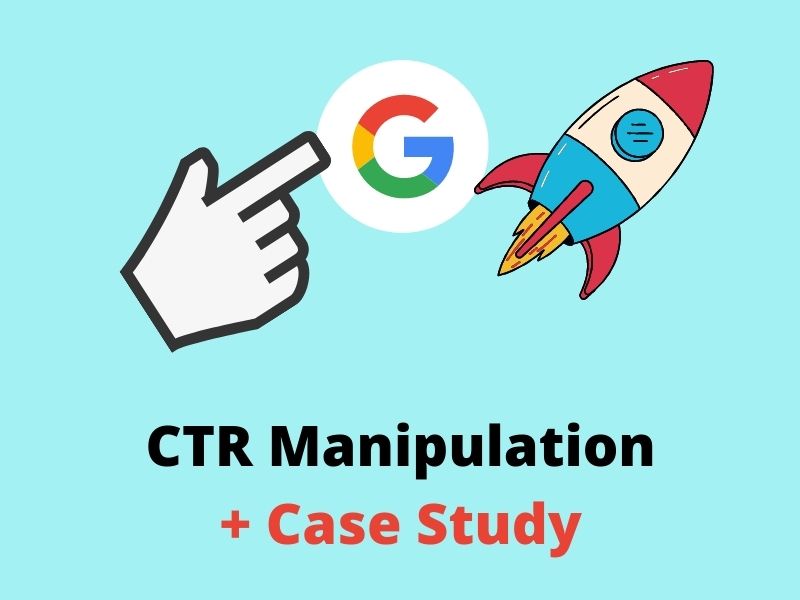The Impact of CTR Manipulation Press Release on Your Digital Marketing
Wiki Article
Attaining Success With Targeted CTR Adjustment
The optimization of click-through prices (CTR) is an important venture for brands intending to improve their digital visibility and make the most of involvement. Targeted CTR manipulation incorporates a range of strategies, from data-driven advertisement positionings to the development of compelling web content customized to specific audiences.Understanding Click-Through Rates
Click-through prices (CTR) function as a critical metric in electronic marketing, mirroring the effectiveness of online web content in driving individual engagement. This metric is calculated by separating the variety of clicks an ad or web link gets by the complete variety of impressions, shared as a percentage (LinkDaddy CTR Manipulation). A higher CTR suggests that the web content reverberates well with the target audience, motivating them to take actionComprehending CTR is essential for marketing professionals intending to enhance their projects. Various aspects affect CTR, consisting of advertisement placement, style, and the importance of the web content to the audience's rate of interests. Engaging headings and visually enticing photos can dramatically boost the possibility of individuals clicking on a link.
Additionally, the context in which the web content exists plays an essential duty in figuring out CTR. Ads presented at calculated times or throughout appropriate occasions are much more likely to capture focus. By assessing CTR data, marketing professionals can determine patterns and locations for enhancement, enabling even more targeted approaches. Inevitably, a thorough understanding of CTR equips marketing experts to improve their methods, ensuring that digital campaigns accomplish their preferred outcomes effectively.
Value of CTR Control
In the affordable landscape of digital advertising, the control of click-through rates (CTR) has actually become a vital strategy for boosting campaign efficiency. CTR acts as a key efficiency indicator, mirroring the effectiveness of on the internet advertisements and web content in attracting individual interaction. A greater CTR not only represents better rate of interest yet also can bring about enhanced online search engine rankings and reduced cost-per-click (CPC) rates, thus maximizing general marketing budget plans.The importance of CTR adjustment lies in its ability to educate marketers regarding consumer choices and actions. By analyzing CTR data, services can determine which components of their campaigns resonate most with their target audience. This insight permits for more enlightened decision-making and the allocation of resources to the most efficient networks.
Additionally, efficient CTR adjustment cultivates an affordable benefit. Brands that regularly accomplish higher CTRs can outperform rivals, safeguarding a more substantial market presence. In a period where consumer attention is fleeting, capturing clicks translates directly to boosted leads and conversions, ultimately driving company growth. Thus, grasping CTR control is not just advantageous; it is important for achieving sustained success in digital marketing initiatives.
Strategies for Targeted CTR
Accomplishing targeted click-through rates (CTR) requires a strategic strategy that includes different methods tailored to specific target market sections. One effective strategy is optimizing ad placements by utilizing data analytics to recognize high-performing networks. By concentrating efforts on these networks, online marketers can improve exposure and rise interaction.One more critical approach is crafting engaging headings and calls to activity (CTAs) A/B testing various variants can disclose which mixes reverberate most with the target market, consequently driving higher CTR. In addition, including visual components such as eye-catching photos or videos can substantially improve allure, making material more shareable and interesting.
Customization also plays a vital duty; making use of user information to produce customized material can foster a sense of significance, encouraging clicks. Leveraging social evidence through testimonies and user-generated material can build depend on, ultimately enhancing CTR.
Studying Individual Actions
 Understanding customer habits is essential for enhancing advertising and marketing strategies and improving total efficiency. By examining how customers interact with web content, marketing professionals can gain useful insights right into choices, motivations, and pain factors. This understanding enables the development of more targeted projects that reverberate with particular audience sections.
Understanding customer habits is essential for enhancing advertising and marketing strategies and improving total efficiency. By examining how customers interact with web content, marketing professionals can gain useful insights right into choices, motivations, and pain factors. This understanding enables the development of more targeted projects that reverberate with particular audience sections.To properly analyze user behavior, numerous tools and methods can be used. Web analytics systems supply information on user interaction metrics such as click-through prices, bounce rates, and time invested on page. Heatmaps and session recordings enable online marketers to imagine user interactions, disclosing which components stand out and which might be forgotten.
Furthermore, user responses through surveys and feedback kinds can provide qualitative understandings, enhancing the understanding of individual view and satisfaction. Segmenting individuals based on actions, demographics, and interests can even more fine-tune targeting efforts, tailoring content to meet diverse demands.
Eventually, continual analysis of customer habits is important for adjusting advertising strategies in real-time. As individual trends evolve, staying in harmony with these adjustments guarantees that projects continue to be pertinent and efficient, page promoting a much deeper link with the target audience. This foundational understanding establishes the stage for the effective application of targeted CTR manipulation methods.
Gauging Success and Changing Techniques
Measuring success in targeted advertising campaigns requires a strategic approach that integrates performance metrics with continuous evaluation. Key efficiency indications (KPIs) such as click-through rates (CTR), conversion prices, and consumer procurement costs should be monitored continuously to assess the performance of manipulation approaches. By developing a baseline, marketers can examine changes in CTR and determine fads that indicate additional hints effective engagement or potential imperfections.Frequently examining these metrics permits the prompt modification of strategies. If a specific project reveals a considerable decline in CTR, it may signal the need for imaginative alterations or a reevaluation of targeting specifications. Using A/B screening can further refine techniques by comparing variants of advertisements or landing web pages, offering insight right into what reverberates ideal with the target market.
Additionally, including qualitative feedback with studies or individual meetings can supplement measurable information, offering a detailed view of target market understanding. Ultimately, the ability to iteratively analyze and fine-tune methods based upon real-time information promotes a more receptive advertising and marketing strategy, making certain this hyperlink that projects continue to be lined up with organization purposes and target market choices. This adaptive method is vital in accomplishing sustained success in targeted CTR manipulation.
Conclusion
Finally, targeted CTR manipulation is essential for maximizing electronic advertising efforts. By recognizing click-through rates and utilizing tactical methods, brand names can efficiently boost customer involvement and drive conversions. Constant analysis of individual habits and persistent measurement of performance indications help with timely modifications, guaranteeing alignment with customer preferences. Eventually, successful CTR control not only boosts presence however additionally promotes count on and integrity, thus adding to continual growth in open markets.
 Targeted CTR manipulation encompasses an array of methods, from data-driven ad placements to the growth of compelling content customized to certain audiences.Click-through prices (CTR) serve as an important metric in electronic advertising, showing the efficiency of on the internet web content in driving customer involvement. A greater CTR shows that the web content resonates well with the target audience, prompting them to take activity.
Targeted CTR manipulation encompasses an array of methods, from data-driven ad placements to the growth of compelling content customized to certain audiences.Click-through prices (CTR) serve as an important metric in electronic advertising, showing the efficiency of on the internet web content in driving customer involvement. A greater CTR shows that the web content resonates well with the target audience, prompting them to take activity.CTR serves as a vital performance indicator, showing the effectiveness of on-line promotions and content in drawing in customer interaction.In final thought, targeted CTR control is important for optimizing digital advertising initiatives.
Report this wiki page